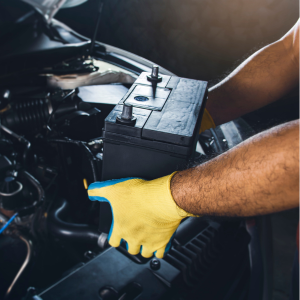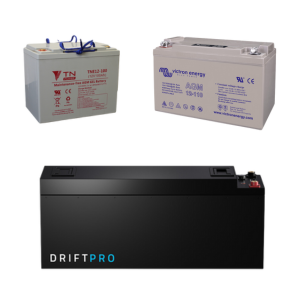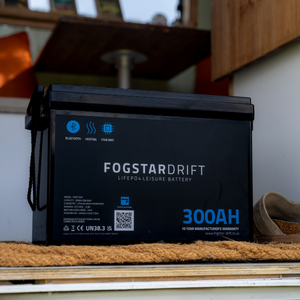The Difference Between 12v Starter and Leisure Batteries
When selecting a 12V battery for your application, understanding the differences between deep cycle and starter batteries is essential. These two types of batteries are designed for distinct purposes and using the right one can greatly affect the performance and longevity of your equipment. This article explores the key differences, applications, and characteristics of deep cycle and starter 12V batteries.
Deep Cycle 12V Batteries
Purpose and Design: Deep cycle batteries are engineered to provide a steady amount of power over a long period. They are designed to be discharged and recharged repeatedly, making them ideal for applications where sustained power is needed.
Key Characteristics:
- Thick Plates: Deep cycle batteries have thicker plates compared to starter batteries. This allows them to endure deep discharges without damaging the plates.
- Low Current, Long Duration: These batteries are optimised to deliver a steady current over extended periods, which is why they can be deeply discharged (up to 50% of their capacity for AGM and lead acid batteries and up to 80% of their capacity for Lithium-Ion batteries) without significant damage.
- Durability: They are built to handle frequent charging and discharging cycles, which enhances their lifespan in applications that require constant use.
Common Applications:
- Auto and Marine Use: Powering appliances and electronics over long trips.
- Solar and Off-Grid Systems: Storing energy from solar panels or wind turbines for use when the renewable sources are not producing power.
Types of Deep Cycle Batteries:
- Flooded Lead-Acid: Require regular maintenance such as adding water.
- Absorbent Glass Mat (AGM): Maintenance-free and more resistant to vibrations.
- Gel Cell: Sealed and maintenance-free, suitable for deep discharge applications.
- Lithium-Ion batteries: these are considered to be the most advanced deep cycle batteries. Their lifespan, weight and the fact that they require very little maintenance makes them superior.
Starter 12V Batteries
Purpose and Design: Starter batteries, also known as cranking batteries, are designed to deliver a large burst of power for a short duration. Their primary function is to start internal combustion engines.

Key Characteristics:
- Thin Plates: Starter batteries have more, thinner plates, which increase the surface area for higher current output.
- High Current, Short Duration: These batteries can deliver a very high current quickly, which is necessary to crank an engine, but they are not designed for deep discharge.
- Quick Recharge: Starter batteries recharge quickly through the vehicle's alternator once the engine is running.
Common Applications:
- Automobiles: Providing the necessary power to start the engine.
- Motorcycles and Small Engines: Delivering quick bursts of power to start smaller engines.
- Emergency Generators: Powering the starter motor to get the generator running.
Types of Starter Batteries:
- Flooded Lead-Acid: The most common type, requiring periodic maintenance.
- AGM: Maintenance-free and more resistant to vibrations, increasingly used in modern vehicles.
Lithium-Ion batteries are not commonly used as starter batteries in most vehicles for many reasons including limitations with cold cranking amps (CCA), voltage drop and the internal BMS's within Lithium-Ion batteries which will be activated by the large amount of current required to crank an engine. Lithium-Ion batteries are sometimes found as starter batteries within motorcycles, jet skis and other smaller vehicles.
Summary of Key Differences Between Deep Cycle and Starter Batteries
Usage Purpose:
- Deep Cycle: Designed for prolonged, steady power output and deep discharges.
- Starter: Designed for short, high-power bursts to start engines.
Plate Construction:
- Deep Cycle: Thicker plates for durability under deep discharge conditions.
- Starter: Thinner plates for maximising surface area and delivering high current.
Discharge Capacity:
- Deep Cycle: Can be deeply discharged (up to 50% for AGM and Lead Acid batteries and up to 80% for Lithium-Ion batteries) regularly without significant damage.
- Starter: Should not be discharged beyond 20-30% as it can damage the battery.
Recharging:
- Deep Cycle: Slower to recharge due to their design and intended use.
- Starter: Designed to be quickly recharged by the vehicle's alternator.
Lifespan:
- Deep Cycle: Longer lifespan in applications requiring frequent deep discharges.
- Starter: Shorter lifespan if used in deep discharge scenarios, but lasts longer in starting applications.
Choosing the Right Battery
Selecting the appropriate battery depends on your specific needs:
- For Starting Engines: Always opt for a starter battery. Its design is optimised for the high current requirements of engine starting.
- For Sustained Power Needs: Choose a deep cycle battery for applications like solar power storage, powering appliances in a campervan or boat, or running electric vehicles and golf carts.
Understanding the differences between deep cycle and starter 12v batteries ensures that you select the right battery for your application, thereby improving performance, reliability, and longevity. Whether you're starting an engine or storing solar energy, using the correct type of battery is crucial for optimal results.
We hope you have found this article useful and as always, if you have any questions, get in touch with us at sales@12voltplanet.co.uk


